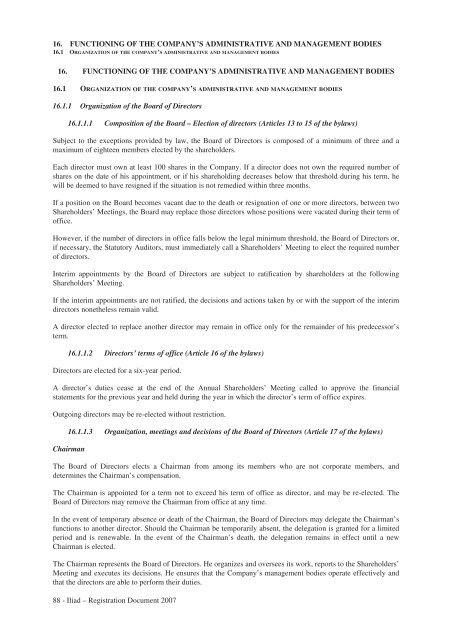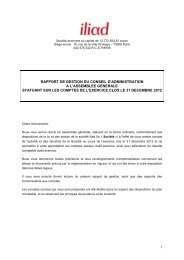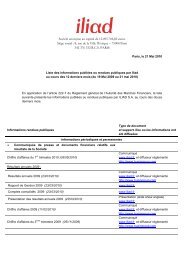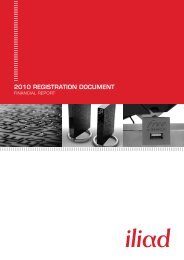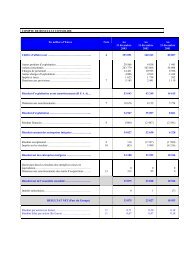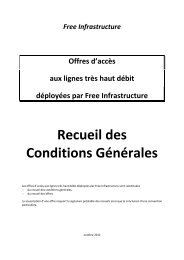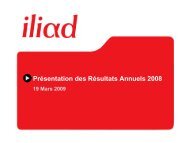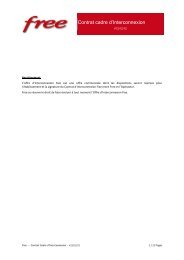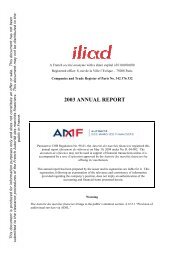REGISTRATION DOCUMENT AND FINANCIAL REPORT - Iliad
REGISTRATION DOCUMENT AND FINANCIAL REPORT - Iliad
REGISTRATION DOCUMENT AND FINANCIAL REPORT - Iliad
- TAGS
- registration
- iliad
- iliad.fr
Create successful ePaper yourself
Turn your PDF publications into a flip-book with our unique Google optimized e-Paper software.
16. FUNCTIONING OF THE COMPANY’S ADMINISTRATIVE <strong>AND</strong> MANAGEMENT BODIES<br />
16.1 ORGANIZATION OF THE COMPANY’S ADMINISTRATIVE <strong>AND</strong> MANAGEMENT BODIES<br />
16. FUNCTIONING OF THE COMPANY’S ADMINISTRATIVE <strong>AND</strong> MANAGEMENT BODIES<br />
16.1 ORGANIZATION OF THE COMPANY’S ADMINISTRATIVE <strong>AND</strong> MANAGEMENT BODIES<br />
16.1.1 Organization of the Board of Directors<br />
16.1.1.1 Composition of the Board – Election of directors (Articles 13 to 15 of the bylaws)<br />
Subject to the exceptions provided by law, the Board of Directors is composed of a minimum of three and a<br />
maximum of eighteen members elected by the shareholders.<br />
Each director must own at least 100 shares in the Company. If a director does not own the required number of<br />
shares on the date of his appointment, or if his shareholding decreases below that threshold during his term, he<br />
will be deemed to have resigned if the situation is not remedied within three months.<br />
If a position on the Board becomes vacant due to the death or resignation of one or more directors, between two<br />
Shareholders’ Meetings, the Board may replace those directors whose positions were vacated during their term of<br />
office.<br />
However, if the number of directors in office falls below the legal minimum threshold, the Board of Directors or,<br />
if necessary, the Statutory Auditors, must immediately call a Shareholders’ Meeting to elect the required number<br />
of directors.<br />
Interim appointments by the Board of Directors are subject to ratification by shareholders at the following<br />
Shareholders’ Meeting.<br />
If the interim appointments are not ratified, the decisions and actions taken by or with the support of the interim<br />
directors nonetheless remain valid.<br />
A director elected to replace another director may remain in office only for the remainder of his predecessor’s<br />
term.<br />
16.1.1.2 Directors’ terms of office (Article 16 of the bylaws)<br />
Directors are elected for a six-year period.<br />
A director’s duties cease at the end of the Annual Shareholders’ Meeting called to approve the financial<br />
statements for the previous year and held during the year in which the director’s term of office expires.<br />
Outgoing directors may be re-elected without restriction.<br />
16.1.1.3 Organization, meetings and decisions of the Board of Directors (Article 17 of the bylaws)<br />
Chairman<br />
The Board of Directors elects a Chairman from among its members who are not corporate members, and<br />
determines the Chairman’s compensation.<br />
The Chairman is appointed for a term not to exceed his term of office as director, and may be re-elected. The<br />
Board of Directors may remove the Chairman from office at any time.<br />
In the event of temporary absence or death of the Chairman, the Board of Directors may delegate the Chairman’s<br />
functions to another director. Should the Chairman be temporarily absent, the delegation is granted for a limited<br />
period and is renewable. In the event of the Chairman’s death, the delegation remains in effect until a new<br />
Chairman is elected.<br />
The Chairman represents the Board of Directors. He organizes and oversees its work, reports to the Shareholders’<br />
Meeting and executes its decisions. He ensures that the Company’s management bodies operate effectively and<br />
that the directors are able to perform their duties.<br />
88 - <strong>Iliad</strong> – Registration Document 2007


